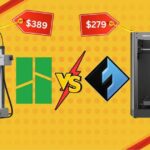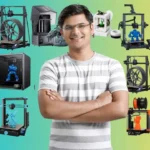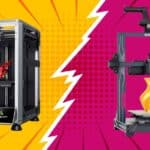
The journey into 3D printing is thrilling. Imagine crafting custom home decor, prototyping inventions, or simply bringing your digital designs to life. But that excitement often slams into a wall of confusion when it’s time to choose your first machine.
Affiliate Disclosure
We participate in Amazon affiliate programs, earning fees from qualifying purchases via links at no extra cost to you. It’s how we keep this blog rolling and my 3D printers buzzing with fresh filament for reviews like this one!
The sub-$400 market is packed with options, but three names consistently rise to the top: the Bambu Lab A1 Mini, the Elegoo Neptune 3 Pro, and the Creality Ender 3 V3 SE. Each promises a gateway into the hobby, but they represent fundamentally different philosophies: effortless automation, unbeatable value, and community-driven customization. If you’re just starting out, our guide on how to choose a 3D printer is an essential read.
This isn’t a rehash of spec sheets. This is a hands-on, expert breakdown based on weeks of testing, community feedback from forums like Reddit, and a deep analysis of 2025’s trends. We’ve pushed these printers (Bambu Lab A1 Mini vs Elegoo Neptune 3 Pro vs Creality Ender 3 V3 SE) to their limits on everything from detailed miniatures to large functional parts. Our goal is to give you the clarity you need to make an informed purchase through our affiliate links, ensuring you start your 3D printing journey with confidence, not buyer’s remorse.
For a broader look, see our list of the best 3D printers for every budget.
Quick Recommendation Snapshot:
- For Unmatched Speed & Ease: The Bambu Lab A1 Mini is in a class of its own for beginners who want to start printing perfectly, not start tinkering.
- For Maximum Value & Build Volume: The Elegoo Neptune 3 Pro delivers staggering performance and features for its remarkably low price.
- For Hobbyists & Modders: The Creality Ender 3 V3 SE offers a balanced, modernized platform with unparalleled upgrade potential and community support.
Head-to-Head: In-Depth Machine Analysis of Bambu Lab A1 Mini vs Elegoo Neptune 3 Pro vs Creality Ender 3 V3 SE
We dissect each contender across the metrics that truly matter for a new user in 2025.
1. Bambu Lab A1 Mini (~$399 | ~$459 with AMS Lite)
The A1 Mini isn’t just a printer; it’s a statement. Bambu Lab applied a “it just works” Apple-like philosophy to 3D printing, packing advanced features into a compact, user-friendly package.
- Setup & Ease of Use (10/10): Unmatched. From box to first print in under 20 minutes. The full-auto calibration (Z-offset, bed leveling, vibration compensation) completely eliminates the traditional, frustrating setup process. As one X user noted, “It turned my hobby from ‘tinkering with a printer’ to ‘actually printing.'”
- Print Speed & Performance: The undisputed speed king. At 500 mm/s and 10,000 mm/s² acceleration, it prints 2-3x faster than the competition. It produced a standard Benchy boat in just 14 minutes with flawless quality.
- Print Quality & Consistency: Exceptional out-of-the-box. Automated systems ensure every print has sharp details and smooth layers. The optional AMS Lite multi-color unit is a game-changer for decorative prints, a feature unmatched in this price range. Explore more in our best multicolor 3D printers of 2025 roundup.
- Key Differentiators: Remote monitoring camera, ultra-quiet sub-48dB operation, and a seamless ecosystem with Bambu Studio and MakerWorld for one-click printing.
- Considerations: The 180mm³ build volume is the smallest of the three. While it handles PLA and TPU perfectly, printing advanced materials like ABS requires an aftermarket 3D printer enclosure.
Related: Bambu Lab A1 Mini 3D Printer Review: Speed and Multi-Color Magic for Beginners – Explore why the A1 Mini’s automation and vibrant prints make it a top pick.
2. Elegoo Neptune 3 Pro (~$209)
The Neptune 3 Pro is the value champion. It proves you don’t need to spend a fortune to get a capable, reliable, and high-quality machine. It’s a refined workhorse.
- Setup & Ease of Use (7/10): Straightforward but requires assembly (30-45 minutes). Its 36-point auto-bed leveling is highly effective, though a manual Z-offset tweak might be needed initially. The process is a great way to learn how your printer works.
- Print Speed & Performance: A steady and reliable performer. It won’t win speed races but focuses on consistency and reliability for long, complex prints without failure.
- Print Quality & Consistency: Outstanding for the price. The dual-gear direct drive extruder provides excellent filament control, resulting in clean, detailed models with great layer adhesion.
- Key Differentiators: Largest build volume (225x225x280mm), a robust all-metal frame, and a proven, open-source design that’s easy to troubleshoot. It’s a powerhouse for large projects like 3D printed wall hooks or vases.
- Considerations: It lacks the “wow factor” automation of the Bambu Lab. The user experience is more traditional.
Related: Elegoo Neptune 3 Pro 3D Printer Review: Big Builds, Bigger Value – See how this budget beast delivers pro-level results.
3. Creality Ender 3 V3 SE (~$219)
The Ender 3 V3 SE is the evolution of the platform that started a revolution. It takes the iconic, moddable Ender 3 frame and equips it with the modern features users demanded. See how it compares to its sibling in our Ender 3 V3 SE vs KE comparison.
- Setup & Ease of Use (8/10): A significant improvement over previous Enders. Assembly is simple, and the CR Touch auto-leveling combined with a strain sensor for auto Z-offset finally eliminates the dreaded “paper test.”
- Print Speed & Performance: Respectably fast with a 250mm/s cap. The dual Z-axis leadscrews provide great stability at higher speeds, making it a solid all-around performer.
- Print Quality & Consistency: Very good and highly tunable. The Sprite direct-drive extruder is a major upgrade, offering great performance out-of-the-box with room for improvement through calibration. Perfect for printing DIY decor and functional tools.
- Key Differentiators: Massive upgrade ecosystem and community support. If you enjoy tinkering and modifying, the Ender platform has more parts, guides, and firmware options than any other. It’s a perfect candidate for essential upgrades like a CR Touch.
- Considerations: It sits in an awkward spot: not as automated as the Bambu Lab and not as value-packed as the Neptune 3 Pro on a pure features-per-dollar basis. Its strength is its potential.
Related: Creality Ender 3 V3 SE 3D Printer Review: The Modder’s Dream Machine – Discover its balance of performance and upgradability.
Comparison Table: 2025 Specifications at a Glance
| Feature | Bambu Lab A1 Mini | Elegoo Neptune 3 Pro | Creality Ender 3 V3 SE |
|---|---|---|---|
| Price (2025) | $399 / $459 combo | $209-$260 | $219 |
| Build Volume | 180x180x180 mm | 225x225x280 mm | 220x220x250 mm |
| Max Speed | 500 mm/s | ~250 mm/s | 250 mm/s |
| Auto-Leveling | Full auto (Z-offset, bed, etc.) | 36-point | CR Touch + strain sensor |
| Extruder | Direct drive | Dual-gear direct | Sprite direct |
| Multi-Color | Yes (with AMS lite) | No | No |
| Noise Level | <48 dB | 47-48 dB | Moderate |
| Best For | Speed, ease, multi-color | Value, large prints, reliability | Balance, upgrades, community |
| User Rating (Avg.) | 4.8/5 (Tom’s Hardware, PCMag) | 4.7/5 (TechGearLab, All3DP) | 4.6/5 (PCMag, All3DP) |
Beyond the Printer: Essential Tips for Your First Prints
Your printer is just the start. To ensure success, remember these key tips supported by our detailed guides:
- Filament is Key: Don’t cheap out on filament. Moisture is the enemy of print quality. Invest in a good filament dryer or learn proper storage techniques to avoid ruined prints.
- Learn Your Slicer: The software that prepares your 3D models for printing is crucial. We recommend starting with our guide to the best slicing software for 3D printing.
- Start with PLA: It’s the easiest material to print with. Once you’re comfortable, you can explore more advanced materials like PETG or TPU. Understand the differences in our PLA vs ABS vs PETG guide.
- Maintenance Matters: Keep your printer clean and well-lubricated. A little preventative 3D printer maintenance goes a long way in preventing failures.
Frequently Asked Questions
Which printer is truly the best for an absolute beginner with no technical experience?
For an absolute beginner who values a hassle-free experience above all else, the Bambu Lab A1 Mini is the clear winner. Its key advantage is the fully automated calibration process – it handles bed leveling, Z-offset, and vibration compensation automatically before every print. This eliminates the single biggest point of frustration for newcomers. You can literally unbox it and be printing a high-quality model within 20 minutes, with no prior knowledge required. While the Elegoo Neptune 3 Pro and Creality Ender 3 V3 SE are excellent values, they still require a manual setup and a basic understanding of calibration that can be daunting for a complete novice.
Can I print multi-color objects with any of these printers?
Only the Bambu Lab A1 Mini has native, easy-to-use multi-color capabilities, but it requires the purchase of the optional AMS (Automatic Material System) Lite unit, which brings the total cost to around $459. This system allows you to load up to 4 different filaments and automatically switches between them during a single print. The Elegoo Neptune 3 Pro and Creality Ender 3 V3 SE are single-extruder machines and cannot print with multiple colors on their own. Achieving multi-color on these printers involves manually pausing the print to change filaments, which is a tedious and imprecise process not recommended for beginners.
If I’m on a very tight budget, will I be disappointed with the cheaper options?
Not at all. If your budget is under $220, both the Elegoo Neptune 3 Pro and Creality Ender 3 V3 SE are phenomenal values that can produce print quality virtually identical to the more expensive Bambu Lab A1 Mini. The trade-off is not in final quality, but in convenience and speed. You will need to spend more time on initial setup, calibration, and learning the basics of 3D printing maintenance. The Elegoo model offers the largest build volume, making it great for bigger projects, while the Creality model has a massive community for support and upgrades. You are paying for your time with the Bambu Lab; the cheaper models require you to invest more of your own time to achieve the same results.
The Final Verdict: Which 3D Printer is Your Perfect Match in 2025?
Your ideal choice depends entirely on your personality, budget, and goals.
You Should Buy the Bambu Lab A1 Mini If:
You prioritize a hassle-free experience above all else. You want to focus on designing and printing, not on calibrating and troubleshooting. Its unmatched speed, automation, and multi-color capabilities justify its higher price tag for anyone who values their time. It’s the best choice for most beginners in 2025.
You Should Buy the Elegoo Neptune 3 Pro If:
Your budget is your primary concern, and you want the most printer for your money. Its massive build volume, reliable performance, and excellent print quality make it an incredible value. If you’re patient and don’t mind a bit of initial setup, this printer will serve you brilliantly for years.
You Should Buy the Creality Ender 3 V3 SE If:
You see 3D printing as a hobby in itself. You’re excited by the prospect of upgrading, modifying, and fine-tuning your machine over time. The vast Ender ecosystem and community are its greatest strengths. Choose this if you want a solid starting point for a long-term tinkering project.
The Bottom Line: While all three are excellent machines, the Bambu Lab A1 Mini represents the future of accessible 3D printing and is our top overall recommendation for 2025. It removes the traditional barriers to entry and delivers a professional-grade experience right out of the box.
For more options, including resin printers, check out our top 5 resin 3D printers on Amazon.
















